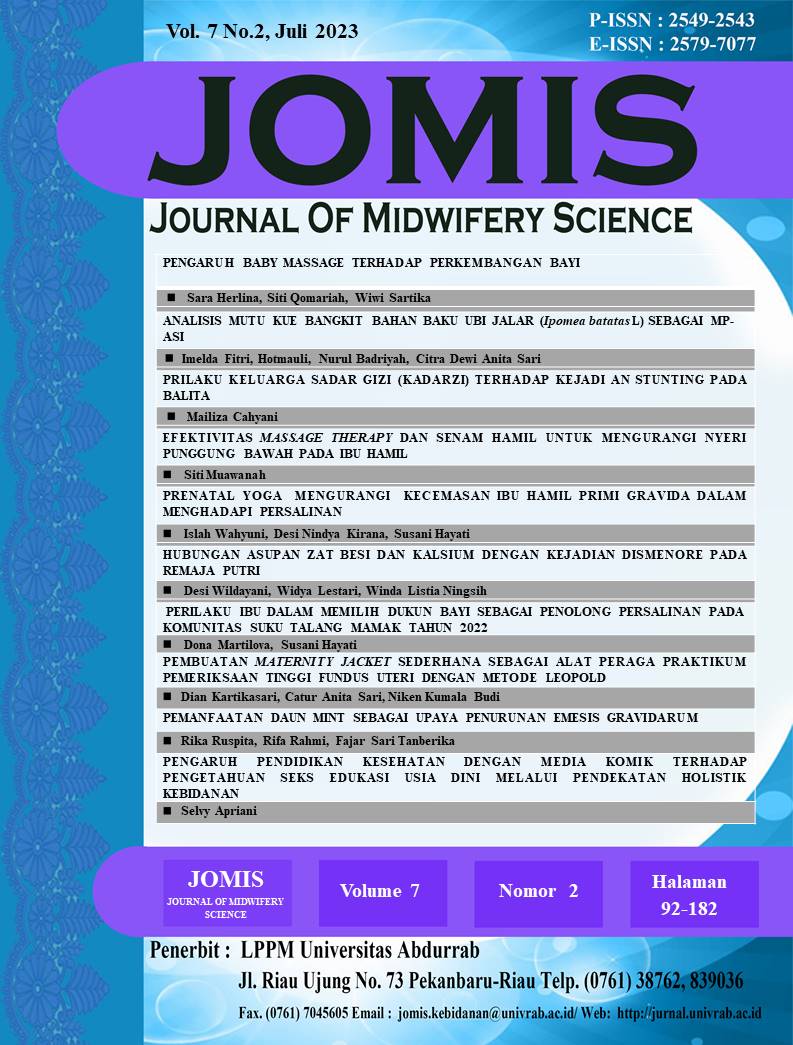HUBUNGAN ASUPAN ZAT BESI DAN KALSIUM DENGAN KEJADIAN DISMENORE PADA REMAJA PUTRI
Abstract
One sign of reproductive maturity in young women is the arrival of menstruation or menstruation (menarche). A common menstrual disorder is painful menstruation (dysmenorrhea), especially during adolescence. The incidence of dysmenorrhea in the world is quite high. The prevalence of menstrual pain in Indonesia consists of 54.89% primary dysmenorrhea and 9.36% secondary dysmenorrhea. If left untreated, dysmenorrhea can develop into pathological conditions, including infertility. Dysmenorrhea that every woman experiences is different, some are a little annoying, but some are unable to carry out activities. Many nutrients, such as magnesium, calcium, vitamin E, and iron, have also been linked to dysmenorrhea. Adequate intake of calcium and iron is believed to reduce dysmenorrhea. The purpose of this study was to determine the relationship between intake of iron and calcium with the incidence of dysmenorrhea in young women at SMP Negeri 16 Padang. This research uses observational analytic method with cross sectional design. The sample in this study were 39 young women (grade IX students) using a proportional random sampling technique. Researchers used a menstrual questionnaire and a 24-hour food recall form. This research was conducted from July to September 2022. The research results were processed using the chi square statistical test. From a study conducted on 39 respondents, it was found that most respondents (61.5%) experienced dysmenorrhea, 30.8% of respondents had insufficient iron intake and most (87.2%) had calcium intake that was less than the adequacy rate. daily minimum nutrition. The results of the bivariate test found that there was no relationship between iron (Fe) intake and the incidence of dysmenorrhea (p value 0.083) and there was no relationship between calcium intake and the incidence of dysmenorrhea in young women at SMPN 16 Padang with p value = 0.062. Adolescent girls should still pay attention to iron and calcium intake in their daily consumption because if the intake is insufficient it can increas.e the risk of dysmenorrhea.
Copyright (c) 2023 JOMIS : Journal of midwifery scinece

This work is licensed under a Creative Commons Attribution-NonCommercial-ShareAlike 4.0 International License.
1. Copyright of all journal manuscripts is held by the JOMIS : Journal of midwifery scinece
2. Formal legal provisions to access digital articles of electronic journal are subject to the provision of the Creative Commons Attribution-ShareAlike license (CC BY-NC-SA), which means that JOMIS : Journal of midwifery scinece is rightful to keep, transfer media/format, manage in the form of databases, maintain, and publish articles.
3. Published manuscripts both printed and electronic are open access for educational, research, and library purposes. Additionally, the editorial board is not responsible for any violations of copyright law.
licensed under a Creative Commons Attribution-ShareAlike 4.0 International License.
 PDF
PDF
 Abstract views: 859
Abstract views: 859
 downloads: 922
downloads: 922

 :
:





